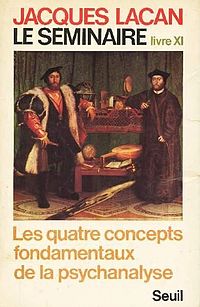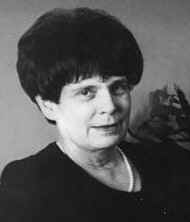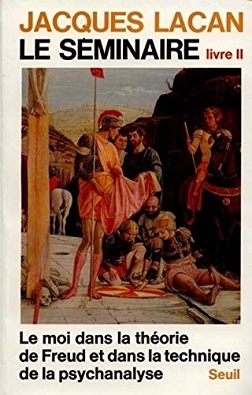| Part of a series of articles on |
| Psychoanalysis |
|---|
 |
In psychoanalysis, foreclosure (also known as "foreclusion"; French : forclusion) [1] is a specific psychical cause for psychosis, [2] according to French psychoanalyst Jacques Lacan.
| Part of a series of articles on |
| Psychoanalysis |
|---|
 |
In psychoanalysis, foreclosure (also known as "foreclusion"; French : forclusion) [1] is a specific psychical cause for psychosis, [2] according to French psychoanalyst Jacques Lacan.
According to Élisabeth Roudinesco, the term was originally introduced into psychology 'in 1928, when Édouard Pichon published, in Pierre Janet's review, his article on "The Psychological Significance of Negation in French": "...[and] borrowed the legal term forclusif to indicate facts that the speaker no longer sees as part of reality'. [3]
According to Christophe Laudou, the term was introduced by Damourette and Pichon. [4]
The publication took part against the background of the Twenties dispute between Freud and René Laforgue over scotomization. 'If I am not mistaken', Freud wrote in 1927, 'Laforgue would say in this case that the boy "scotomizes" his perception of the woman's lack of a penis. A new technical term is justified when it describes a new fact or emphasizes it. This is not the case here'. [5] Freud went on to suggest that if one wanted to 'reserve the word " Verdrängung " ["repression"] for the affect, then the correct German word for the vicissitude of the idea would be " Verleugnung " ["disavowal"]'. [6]
In 1938 Lacan relates the origin of psychosis to an exclusion of the father from the family structure thereby reducing this structure to a mother-child relationship. [7] Later on, when working on the distinctions between the real, imaginary and symbolic father, he specifies that it is the absence of the symbolic father which is linked to psychosis.
Lacan uses the Freudian term, Verwerfung, [1] which the "Standard Edition" translates as "repudiation", [1] as a specific defence mechanism different from repression, "Verdrängung", in which "the ego rejects the incompatible idea together with its affect and behaves as if the idea has never occurred to the ego at all." [8] In 1954 basing himself on a reading of the "Wolf Man" [9] Lacan identifies Verwerfung as the specific mechanism of psychosis where an element is rejected outside the symbolic order as if it has never existed. [10] In 1956 in his Seminar on Psychoses he translates Verwerfung as forclusion, that is foreclosure. [11] "Let us extract from several of Freud's texts a term that is sufficiently articulated in them to designate in them a function of the unconscious that is distinct from the repressed. Let us take as demonstrated the essence of my Seminar on the Psychoses, namely, that this term refers to psychosis: this term is Verwerfung (foreclosure)". [12]
The problem Lacan sought to address with the twin tools of foreclosure and the signifier was that of the difference between psychosis and neurosis, as manifested in and indicated by language usage. It was common analytic ground that "when psychotics speak they always have some meanings that are too fixed, and some that are far too loose, they have a different relation to language, and a different way of speaking from neurotics." [13] Freud, following Bleuler and Jung had pointed to 'a number of changes in speech...in schizophrenics...words are subjected to the same process as that which makes the dream'. [14] Lacan used foreclosure to explain why.
When Lacan first uses the Freudian concept of Verwerfung (repudiation) in his search for a specific mechanism for psychosis, it is not clear what is repudiated (castration, speech). In 1957 in his article "On a question preliminary to any possible treatment of psychosis" [15] that he advances the notion that it is the Name-of-the-Father (a fundamental signifier) that is the object of foreclosure. In this way Lacan combines two of his main themes on the causality of psychosis: the absence of the father and the concept of Verwerfung. This ideas remains central to Lacan's thinking on psychosis throughout the rest of his work.
Lacan considered the father to play a vital role in breaking the initial mother/child duality and introducing the child to the wider world of culture, language, institutions and social reality — the Symbolic world — the father being "the human being who stands for the law and order that the mother plants in the life of the child...widens the child's view of the world." [16] The result in normal development is "proper separation from the mother, as marked out by the Names-of-the-father." [17] Thus Lacan postulates the existence of a paternal function (the "Name of the Father" or "primordial signifier") which allows the realm of the Symbolic to be bound to the realms of the Imaginary and the Real. This function prevents the developing child from being engulfed by its mother and allows him/her to emerge as a separate entity in his/her own right. It is a symbol of parental authority (a general symbol that represents the power of father of the Oedipus complex) that brings the child into the realm of the Symbolic by forcing him/her to act and to verbalise as an adult. As a result, the three realms are integrated in a way that is conducive to the creation of meaning and successful communication by means of what Lacan calls a Borromean knot.
When the Name-of-the-Father is foreclosed for a particular subject, it leaves a hole in the Symbolic order which can never be filled. The subject can then be said to have a psychotic structure, even if he shows none of the classical signs of psychosis. When the foreclosed Name-of-the-Father re-appears in the Real, the subject is unable to assimilate it and the result of this collision between the subject and the inassimilable signifier of the Name-of-the-father is the entry into psychosis proper characterized by the onset of hallucinations and/or delusions. [18] In other words, when the paternal function is "foreclosed" from the Symbolic order, the realm of the Symbolic is insufficiently bound to the realm of the Imaginary and failures in meaning may occur (the Borromean knot becomes undone and the three realms completely disconnected), with "a disorder caused at the most personal juncture between the subject and his sense of being alive." [19] Psychosis is experienced after some environmental sign in the form of a signifier which the individual cannot assimilate is triggered, and this entails that "the Name-of-the-Father, is foreclosed, verworfen, is called into symbolic opposition to the subject." [19] The fabric of the individual's reality is ripped apart and no meaningful Symbolic sense can be made of experience. "Absence of transcendence of the Oedipus places the subject under the regime of foreclosure or non-distinction between the symbolic and the real'; [20] and psychotic delusions or hallucinations are the consequent result of the individual's striving to account for what he/she experiences.

Jacques Marie Émile Lacan was a French psychoanalyst and psychiatrist. Described as "the most controversial psycho-analyst since Freud", Lacan gave yearly seminars in Paris from 1953 to 1981, and published papers that were later collected in the book Écrits. His work made a significant impact on continental philosophy and cultural theory in areas such as post-structuralism, critical theory, feminist theory and film theory, as well as on the practice of psychoanalysis itself.
In the psychoanalytic theory of Jacques Lacan, objet petit a stands for the unattainable object of desire, the "a" being the small other ("autre"), a projection or reflection of the ego made to symbolise otherness, like a specular image, as opposed to the big Other which represents otherness itself. It is sometimes called the object cause of desire, as it is the force that induces desire towards any particular object. Lacan always insisted that the term should remain untranslated, "thus acquiring the status of an algebraic sign" (Écrits).
The objet petit a is what falls from the subject in anxiety.
Phallocentrism is the ideology that the phallus, or male sexual organ, is the central element in the organization of the social world. Phallocentrism has been analyzed in literary criticism, psychoanalysis and psychology, linguistics, medicine and health care, and philosophy.
In continental philosophy, the Real refers to the remainder of reality that cannot be expressed, and which surpasses reasoning. In Lacanianism, it is an "impossible" category because of its opposition to expression and inconceivability.
[T]he real in itself is meaningless: it has no truth for human existence. In Lacan's terms, it is speech that "introduces the dimension of truth into the real."

The Imaginary is one of three terms in the psychoanalytic perspective of Jacques Lacan, along with the Symbolic and the Real. Each of the three terms emerged gradually over time, undergoing an evolution in Lacan's own development of thought. "Of these three terms, the 'imaginary' was the first to appear, well before the Rome Report of 1953…[when the] notion of the 'symbolic' came to the forefront." Indeed, looking back at his intellectual development from the vantage point of the 1970s, Lacan epitomised it as follows:
"I began with the Imaginary, I then had to chew on the story of the Symbolic ... and I finished by putting out for you this famous Real."
The Symbolic is the order in the unconscious that gives rise to subjectivity and bridges intersubjectivity between two subjects; an example is Jacques Lacan's idea of desire as the desire of the Other, maintained by the Symbolic's subjectification of the Other into speech. In the later psychoanalytic theory of Lacan, it is linked by the sinthome to the Imaginary and the Real.
The Borromean clinic is a model of psychoanalytic practice advanced in the late work of Jacques Lacan. It takes its name from the Borromean knot.
In the theory of Jacques Lacan, demand represents the way instinctive needs are inevitably alienated through the effects of language on the human condition. The concept of demand was developed by Lacan in parallel to those of need and desire to account for the role of speech on human aspirations. Demand forms part of Lacan's battle against the approach to language acquisition favored by ego psychology, and makes use of Kojeve's theory of desire. Demand is not a Freudian concept.

Jean-Claude Maleval is a French Lacanian psychoanalyst, member of the École de la Cause Freudienne and emeritus professor of clinical psychology at the University of Rennes 2.
Sinthome is a concept introduced by Jacques Lacan in his seminar Le sinthome (1975–76). It redefines the psychoanalytic symptom in terms of the role of the subject outside of analysis, where enjoyment is made possible through creative identification with the symptom.

The Four Fundamental Concepts of Psychoanalysis is the 1978 English-language translation of a seminar held by Jacques Lacan. The original was published in Paris by Le Seuil in 1973. The Seminar was held at the École Normale Supérieure in Paris between January and June 1964 and is the eleventh in the series of The Seminar of Jacques Lacan. The text was published by Jacques-Alain Miller.
"The Instance of the Letter in the Unconscious, or Reason Since Freud" is an essay by the psychoanalyst Jacques Lacan, originally delivered as a talk on May 9, 1957 and later published in Lacan's 1966 book Écrits.
In Jacques Lacan's psychoanalytic philosophy, lack is a concept that is always related to desire. In his seminar Le transfert (1960–61) he states that lack is what causes desire to arise.

Maud Mannoni was a French psychoanalyst of Belgian origin, who married Octave Mannoni and became a major figure of the Lacanian movement.
The name of the father is a concept that Jacques Lacan developed from his seminar The Psychoses (1955–1956) to cover the role of the father in the Symbolic Order.
Serge Leclaire was a French psychiatrist and psychoanalyst. Initially analyzed by Jacques Lacan, he 'became the first French "Lacanian"'.

The Ego in Freud's Theory and in the Technique of Psychoanalysis is the 1988 English-language translation of published in Paris by Le Seuil in 1977. The text of the Seminar, which was held by Jacques Lacan at the Hospital of Sainte-Anne in Paris between the Fall of 1954 and the Spring of 1955 and is the second one in the series, was established by Jacques-Alain Miller and translated by Sylvana Tomaselli.
Lacanianism or Lacanian psychoanalysis is a theoretical system that explains the mind, behaviour, and culture through a structuralist and post-structuralist extension of classical psychoanalysis, initiated by the work of Jacques Lacan from the 1950s to the 1980s. Lacanian perspectives contend that the world of language, the Symbolic, structures the human mind, and stress the importance of desire, which is conceived of as endless and impossible to satisfy. Contemporary Lacanianism is characterised by a broad range of thought and extensive debate between Lacanians.
Scotomization is a psychological term for the mental blocking of unwanted perceptions, analogous to the visual blindness of an actual scotoma.
Bruce Fink is an American Lacanian psychoanalyst and a major translator of Jacques Lacan. He is the author of numerous books on Lacan and Lacanian psychoanalysis, prominent among which are Lacan to the Letter: Reading Écrits Closely, The Lacanian Subject: Between Language and Jouissance (1995), Lacan on Love: An Exploration of Lacan's Seminar VIII and A Clinical Introduction to Lacanian Psychoanalysis: Theory and Technique.